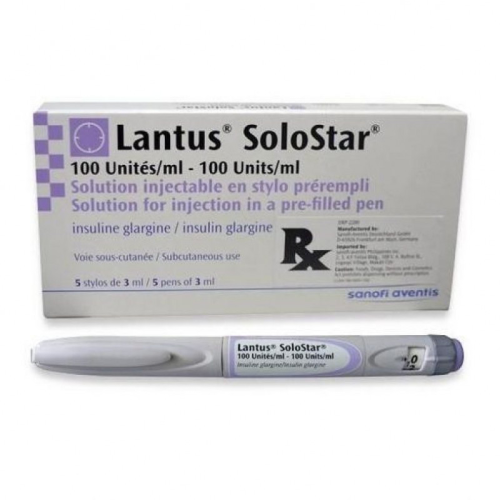CLASSIFICATION
Hormone and Synthetic Substitute / Antidiabetic Agent
ACNE
No
WATER RETENTION
No
HBR
No
HEPATOTOXICITY
No
AROMATIZATION
No
MANUFACTURER
Sanofi
WAREHOUSE
International Warehouse 2
SUBSTANCE
Insulin Glargine
,
Insulin is a potent anabolic hormone that is naturally produced by the human body and is crucial for maintaining proper bodily functions. While it is generated by the body, those diagnosed with diabetes often receive insulin through external means. Some athletes also use it to promote lean muscle growth; however, misuse can be extremely dangerous and should always be approached with great caution.
Although insulin is synthesized by all humans, exogenously sourced insulin emerged in the 1920s. Initially, it was not a synthetic product but was extracted from the pancreases of dogs and later from cattle and pigs. Despite purity concerns, the introduction of external insulin was hailed for its life-saving potential, as untreated diabetes can be fatal. By the 1970s, these purity issues were largely addressed, leading to the launch of synthetic insulin by Ciba in 1975. By 1982, the synthetic version known as Humulin-R was developed, which replicates human insulin perfectly and received FDA approval.
Functions and Characteristics of Insulin
Insulin is a peptide hormone generated by the pancreas, playing a critical role in the regulation and utilization of glucose, amino acids, and fatty acids. It also inhibits the metabolic breakdown of carbohydrates, fats, and proteins.
Diabetics fall into two categories that necessitate insulin use: Type I diabetes, where individuals do not produce sufficient insulin, and Type II diabetes, where the body produces insulin but fails to utilize it effectively, often due to obesity.
As a beneficial hormone, insulin acts positively on the liver by promoting the conversion of glycogen to glucose while inhibiting the conversion of non-carbohydrate sources to glucose. Insulin facilitates the uptake of glucose by cells, which can promote muscle growth. High insulin levels are linked to increased protein synthesis and enhanced bone density, as well as raising levels of Insulin-Like Growth Factor-1 (IGF-1), another anabolic hormone that shares structural similarities with insulin.
Furthermore, insulin also plays a role in boosting Luteinizing Hormone (LH) and Follicle Stimulating Hormone (FSH) levels, which may lead to an increase in testosterone production, albeit the effect is relatively modest.
Effects of Insulin
The primary effect of insulin, regardless of the type of diabetes, is the regulation of blood sugar levels. Owing to its strong anabolic and anti-catabolic properties, insulin can be advantageous for various athletes. However, the off-label use of insulin by non-diabetics can lead to significant fat gain and potentially fatal situations if not used properly.
Notwithstanding the risks, some athletes see the anabolic benefits of insulin as worthwhile, provided they manage body fat. High insulin levels can hinder the body's ability to burn stored fat, necessitating a carefully planned diet to ensure that nutrients are deposited in muscle rather than fat stores. Optimal usage timing for insulin is immediately after intense weight training, ideally accompanied by food.
With proper application, insulin can lead to rapid increases in lean muscle mass, though managing body fat can be challenging. It is generally recommended to combine insulin use with anabolic steroids and Human Growth Hormone (HGH) in competitive settings to foster greater muscle growth and improved fat management.
Side Effects of Insulin
Insulin use can lead to various side effects, chiefly hypoglycemia. While this condition is typically manageable for diabetic patients with correct dosing, it poses a substantial risk in performance contexts. Hypoglycemia, characterized by dangerously low blood sugar levels, carries severe consequences, including potential death.
Common symptoms of hypoglycemia include:
If hypoglycemic symptoms appear, immediate consumption of fast-acting carbohydrates is critical. This can include candy or sugary drinks. It is also advisable not to sleep after taking insulin due to the risk of falling into a hypoglycemic state, which could be life-threatening. Severe hypoglycemia necessitates urgent medical attention, and it is important to have someone present during insulin administration to mitigate risks.
Though hypoglycemia can generally be corrected, it carries the risk of leading to a diabetic coma or, in worst-case scenarios, death. Rarely, users may experience allergic reactions or localized fat accumulation at injection sites, which can occur with repeated injections in the same area.
Insulin Administration
For diabetes management, insulin dosage varies widely based on individual needs. In performance contexts, there are multiple insulin forms available, and common recommendations suggest an initial dose of 1 IU per 10 pounds of body weight. First-time users should start at a lower dose, such as 1 IU post-workout, increasing gradually until a suitable range is found.
Administration should always occur right after weight training, followed by the consumption of carbohydrates and protein to avoid the onset of hypoglycemia. A minimum of 100 grams of carbohydrates is typically advised.
Athletes considering insulin must have fast-acting carbohydrates on hand during administration and are encouraged to consume an additional meal shortly after the post-injection meal.
Insulin Summary
Insulin is crucial for health and optimal bodily function. For athletes, it can significantly contribute to muscle building; however, its use is fraught with risks. Many men may find they achieve better physique goals without it. Insulin is particularly prevalent in competitive bodybuilding but should be approached with caution, especially for those who may struggle to manage body fat. Furthermore, athletes seeking to evade drug tests may misuse insulin in combination with other hormones, often at lower doses.

